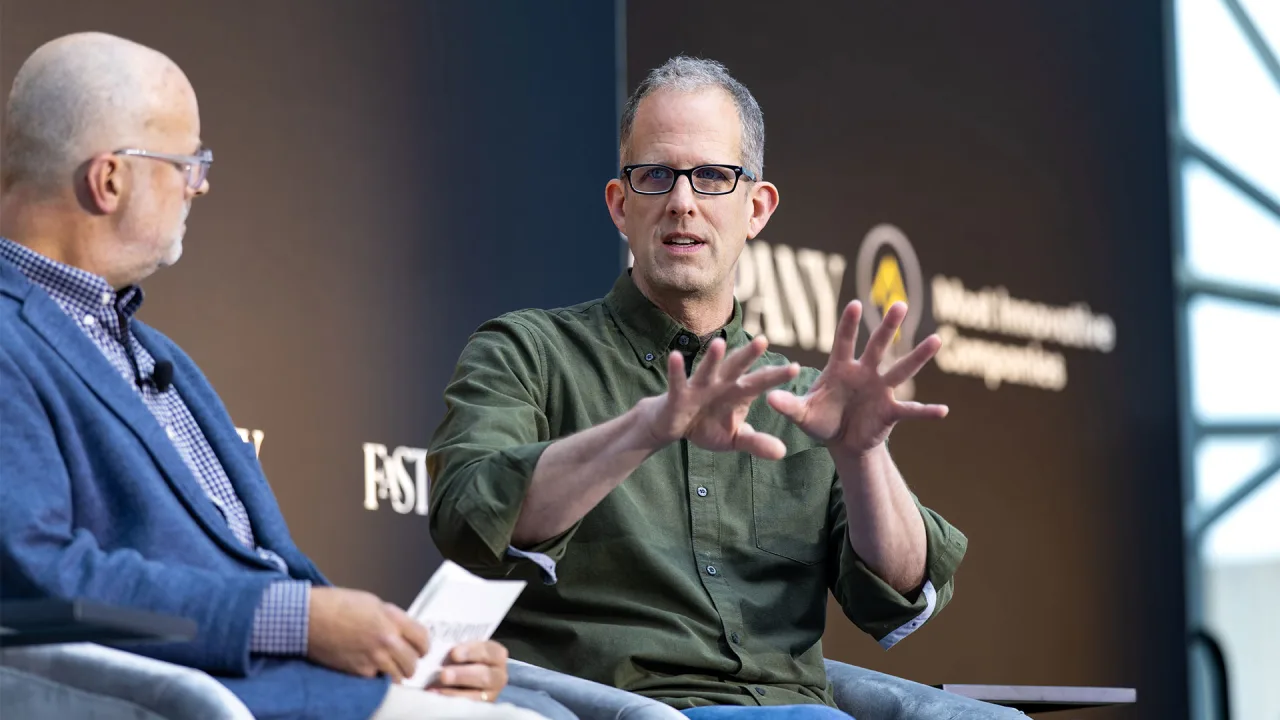Upcycling and Upskilling With AI: Goodwill’s Steve Preston
Many of us know Goodwill Industries International as a retailer that accepts and resells donated goods. What the average consumer may not know is that the nonprofit takes in over 5 billion pounds of goods each year — and not all of it can be resold. For those unwanted or unviable items, the organization can […]

Many of us know Goodwill Industries International as a retailer that accepts and resells donated goods. What the average consumer may not know is that the nonprofit takes in over 5 billion pounds of goods each year — and not all of it can be resold. For those unwanted or unviable items, the organization can either look into recycling or upcycling, and with the help of AI, it’s able to efficiently make that determination while also improving its process for sorting and allocating sellable goods for different retail channels.
Additionally, Goodwill helps its workforce with career development skills. Much of this training has been enhanced with AI. Tune in to this episode to hear directly from Goodwill CEO Steve Preston about how the organization is using technology to fulfill a mission that extends beyond the retail store.
Subscribe to Me, Myself, and AI on Apple Podcasts or Spotify.
Transcript
Sam Ransbotham: Goodwill Industries takes in over 5 billion pounds of retail goods each year and increasingly uses AI to help sort, distribute, and potentially recycle those goods.
On today’s episode, the CEO describes not only its retail operations but also how Goodwill is using AI to assist in human skilling and reskilling.
Steve Preston: I’m Steve Preston from Goodwill Industries, and you’re listening to Me, Myself, and AI.
Sam Ransbotham: Welcome to Me, Myself, and AI, a podcast on artificial intelligence in business. Each episode, we introduce you to someone innovating with AI. I’m Sam Ransbotham, professor of analytics at Boston College. I’m also the AI and business strategy guest editor at MIT Sloan Management Review.
Shervin Khodabandeh: And I’m Shervin Khodabandeh, senior partner with BCG and one of the leaders of our AI business. Together, MIT SMR and BCG have been researching and publishing on AI since 2017, interviewing hundreds of practitioners and surveying thousands of companies on what it takes to build and to deploy and scale AI capabilities, and really transform the way organizations operate.
Sam Ransbotham: Hey, everyone. Thanks for joining us. I don’t want to overpromise, but I think this episode could be pretty interesting. Today, Shervin and I are talking with Steve Preston. He’s the CEO of Goodwill Industries. Steve, thanks for taking the time to chat with us.
Steve Preston: Thanks for having me. I’m looking forward to it.
Sam Ransbotham: So I’m guessing that most of our listeners are pretty familiar with Goodwill as a retail establishment. But there’s a lot more to Goodwill than just retail, and I’m hoping that we can dig into that as we talk. But first, Steve, maybe we start with you elaborating on the retail part of Goodwill and, in particular, what that has to do with artificial intelligence.
Steve Preston: We are the largest player in the resale marketplace, and we bring in about 5 billion pounds of goods every year. And those are largely kept out of the waste stream. We bring those goods in, we touch every one of them, we price them, we evaluate them, we decide what channel to sell them through. If they’re broken or not able to be resold, we are likely to be looking for recycling channels. Our supply chain from beginning to end is very complicated [and] requires a lot of human intervention, a lot of decision points, and a lot of judgment. So throughout that process, we see a lot of opportunities to incorporate AI in the entire flow of goods, the decision-making process, and making sure that everything we receive finds its best home somewhere in the cycle.
Sam Ransbotham: I think that’s interesting. Until we talked the first time, a couple of weeks ago, I hadn’t really thought about the problem you have. Most retailers take a bunch of goods in [and] they’re homogenous goods. They know where they’re headed, they know what the good is. Explain how artificial intelligence can help with that problem of the 5 billion pounds and figuring out what that should be and where it should go.
Steve Preston: We think that there are a number of AI applications throughout the production process. First of all, if we bring in a large volume of goods, as I mentioned before, every good is evaluated from some perspective. The whole process of identifying what the good is, what the best home for that good is, and then how to route it can involve any number of AI applications. Everything we get is unique. We sell some things in our stores. We sell some things online. Many of our local communities actually have boutique stores. And some of it we actually sell to other third parties.
The other piece that is really interesting and very important is the fact that the infrastructure in our country for textile recycling is beginning to emerge. Historically, the recycling technologies have been fairly basic for clothing — really kind of mechanical technologies. But what we see is a lot more demand and a lot more investment in technologies that turn polyester fibers all the way back into polyester pellets, which can then be used to spin fibers [to] go back into making textiles and back into clothing — really, complete circularity. That’s very important given some of the trends we see worldwide. We are, in fact, partnering with a very sophisticated, very promising provider who’s looking at facilities right now in the United States. And when we get to that point, AI can actually identify the fiber composition of our textiles.
Shervin Khodabandeh: You’re talking about computer vision, right?
Steve Preston: [I’m] talking about computer vision and evaluating sort of [the] percentage of polyester, in this case a particular textile. And then with the support of the production technology, [we’ll] automatically sort it and then, actually, route it to a process that would actually begin pulling those garments apart, taking out anything we can’t use, and shredding it, and then turning it right into feedstock for the recycling facilities.
Shervin Khodabandeh: This is actually quite fascinating. Sam, I like the contrast you were making with traditional retail, which itself is actually pretty hard.
It’s a very complex series of precision optimization problems, right? From what to buy, when to buy, where to buy, how to buy, where to sell, who to sell [to], who sells it — it’s all of that. But there is an ability for a typical retailer to have a strategy on SKUs that they have, and the categories and category management, and the merchandising function. I’m curious, how do you think about the plethora of stuff that comes in? Because you can’t really control what comes in, but you have an ability to control what gets put in stores or on the e-commerce platform. How do you think about that, the wide range of stuff?
Steve Preston: Generally, we will accept what people bring us, with the exception of things that are, you know, hazardous waste. The interesting thing here is that as recycling technologies expand, we can begin telling people, “Bring us the stuff that you can’t wear. Bring us the stuff that’s torn, or if it’s stained or whatever. Bring us everything. Because you know what, we have a system that is completely circular. We have a system that is the most environmentally advanced, and we will be your steward of that.”
It really begins, over time, to expand what we mean to the environment. Because today, the most valuable thing you can do is keep something in use for as long as possible, right? We do that with billions of pounds of things every year. This actually expands the scope for us, and by virtue of our ability to do more things, we have, as I said before, a more complete, more circular solution.
Sam Ransbotham: I like that because one of the things [when] I sit around thinking about stuff I don’t have a use for anymore [is] “Oh, somebody ought to be able to use that.” But then I look at it and it’s got a stain or whatever, and I say, “Oh, nobody’s going to use that.” If you could take that decision-making away from the donation part, that seems huge.
Steve Preston: It is huge.
Sam Ransbotham: Then you can optimize what happens to that in a way that I can’t.
Steve Preston: We still make many of those decisions today.
If something is fundamentally not wearable, it may turn into filler for some kind of industrial application. If it’s a broken toy, we work with different recyclers. Actually, we’ve got a partnership in Phoenix right now, where unrecyclable plastics are being turned into products through extrusion technologies and other things. So we have plastic bags that are decking material now. We’re pretty creative. One of the reasons I think we’re so creative is because Goodwill is not a monolithic organization. We’re a collection of 153 local independent 501(c)(3) [organizations] that are deeply embedded in their communities, know the challenges they have, the opportunities they have, and are very responsive. So that allows us to try a lot of different things in a lot of places based on the ingenuity of those local leaders.
Shervin Khodabandeh: That’s wonderful. We’ve talked so far about the theme of AI dramatically improving the ability to analyze, to sort, and to optimize this pretty heterogeneous supply-to-demand equation.
Are you using AI to help optimize what’s happening in stores with people and associates, and all that?
Steve Preston: Yeah. The AI-people connection comes to us in a number of different reflections. First of all, we have a large grant from Google right now with the goal of providing 200,000 people with core AI skills. Now, what most people don’t know about Goodwill is the mission behind the store. And that is, we’re the largest provider of workforce development services on the continent. We work with people — many of whom have had challenges in life, many of whom have lower levels of education, people in poverty — to help them get on their feet, get the training and development they need to be able to move successfully into the workforce, or from where they are in the workforce to better jobs. So 83% of the people we serve have a high school degree or less — many have come out of incarceration [or] have had long-term periods of unemployment, etc.
Many of those people we employ in the stores, and many of those people we support not in the stores but in separate job centers. We supported about 1.7 million people in job centers last year, and we have 140,000 employees. So those are two domains where foundational training and development [are] key.
We have the opportunity to reach both of those populations with core AI skills. Google has actually given us the curriculum for that. In addition, many of those people are going through skills training classes or other kinds of workforce readiness training. Increasingly, AI is able to do a number of things. No. 1: We believe that with the right tools, we can — through assessments of those people, understanding what their skills are, what their challenges are, what their aspirations are — design a program very quickly that makes sure that we provision the right kind of support.
Whether it’s helping them find housing, whether it’s helping them learn how to work in the workplace, whether it’s math skills — what is it going to take to help that person move forward in life, and how do we design that pathway?
Shervin Khodabandeh: [It’s a] very individualized curriculum.
Steve Preston: That’s what we do today already. That is our core work. But to have the supportive AI to do the evaluation and map it out and automate that process is powerful. Secondly, there are terrific emerging applications to help the learner. So if [you] do poorly on a test, let’s come right back to you and have you try these exercises, or let’s come back to you and support you in this way.
Let’s talk about how to use this spreadsheet program. Let’s talk to you about core interview skills. We’ve actually been testing some [virtual reality] headset-type technologies for mock interviews. There are applications now emerging that help people with resume writing and other types of interview prep. And we’re working with some partners right now who are developing automated connectivity to help people who qualify for governmental support but have no idea [that they do].
So I think it could be absolutely transformative for people’s lives, both [for] our employees who need [this] support as well as the over a million people who come to our job centers.
Shervin Khodabandeh: One example of this is, would it be the Goodwill Digital Navigator [Certificate] Specialization program or something like that?
Steve Preston: We have something called the [Goodwill] Career [Coach and Navigator Professional Certificate], which is a very intensive training program for those professionals on our team that work with individuals.
Shervin Khodabandeh: I see.
Steve Preston: And we’ve just rolled out something called the Digital Career Navigator, because digital skills are such a door opener for people who don’t have them. We are layering AI skills into that digital training. Because it’s essential now. We’re not only helping our people understand those skills and how to work with people who develop them, but we’re building AI skills into our digital training programs for those participants in the programs.
Sam Ransbotham: I was thinking [as you said that], I love all these ideas, they seem great. Yes, let’s skill people [and] use AI to do that. It just seems really hard. I love the idea of a program that would look at someone and for them to decide exactly what they should be working on and what skills they [need]. But where does that AI come from that does that? Is that something you’re developing? Are you getting it from somewhere? Where does that come from?
Steve Preston: Right now, we do those things ourselves with our expertise. When somebody comes through our door, in many cases, we’ll do deep evaluations on them and understand their needs. We’ll look at the jobs in their local job market.
Sam Ransbotham: These are people you’re talking about, one-on-one people?
Steve Preston: Human beings that come through the door.
We look at local job market data. We look at data on their scores. We look at interviews, like where are [their] challenges? We put together that picture, and then we have relationships in local communities often, where we partner with providers of other human services that we don’t provide but that [an] individual needs. We’ll play the coordinator role as well. So we know how to do all that stuff, and what we’re talking about now is bringing in AI to simplify it, to automate it, and to enhance it. Because there’s only so much an individual can do.
When we look at what is developing right now, what I would say is, we’re beginning to see some pockets of it. We see AI applications right now that are working on the point where an individual is ready for something, and helping them with their resumes and their interview skills and their approach and that side of it. As I mentioned before, we see AI developing to connect networks. It’s not hard to imagine that we could incorporate AI to connect to those things but also support the intake and evaluation process, and then map it out. It’s evolving very quickly.
There are people in the nonprofit space — let me just say, there are people in the foundation kind of well-heeled nonprofit space — [who] are putting money into these things. We’re talking to many of them.
Shervin Khodabandeh: We’re seeing instead of a company going and building everything or buying everything, there’s these ecosystems that are coming together to make these things happen.
Steve Preston: Yeah. And the large technology providers are embedding them in their platforms. If you’re using Google for your workplace applications, it’s all embedded in there. My Apple phone has all sorts of stuff. Microsoft has Copilot. Some of these things are fairly basic, but for organizations that are looking to take big steps forward when it comes to automating the financial function and HR function, and workflows and simplifying writing and marketing, those are ready. They’re in the box.
The great thing is people can begin getting value today. These more unique applications obviously need to be driven by people who are in particular niches. But what’s interesting for us is in some of the places that we deal, we’re already finding social entrepreneurs who are really excited to find solutions to make our world better, and care about the same things we do, and really kind of leading the way. We have an opportunity to test it and work with them. It’s very exciting.
Sam Ransbotham: The excitement seems real to me in terms of — I don’t want to denigrate other uses of AI — but let’s say we help some finance company get a slightly faster transaction on their high-frequency trading through these algorithms. It’s hard to get too excited about that, but when you’re talking about [seeing] people whose lives change through this process, that has to be a very good feeling.
Steve Preston: It’s great. One of the challenges, I think, in working with people who have many barriers in life is understanding how to be with them when you need to … support them through a difficult patch or a difficult issue. You can imagine somebody taking a class and getting frustrated and wanting to give up. You’ve got this automated solution coming forward saying, “Hey, I see you’re having a problem with these six areas. Let’s take a step back and help you work through this,” in that place, at their speed, when and where they can, because they may have three kids, and they put them to bed at 9:30 at night. And this is the only time they have.
It’s remarkable in helping to meet people where they are, not only in terms of their need but also what’s going on in their life. I think about the people and the challenges and how they connect. I get really excited that it helps them work through these things at a pace and in a way and in pockets where it’s possible for them.
Sam Ransbotham: What made you think that artificial intelligence might be a big part of this solution here?
Steve Preston: The whole emergence of generative AI and the broader kind of consciousness of leaders in this country happened very rapidly, and sort of alongside that, I think I increasingly got visibility into the different potential applications. The combination of seeing what was developing and wondering what could develop, when I thought about the problem set that we face, pulled me and many other leaders across Goodwill. I think some of the smartest thinking in AI at Goodwill is happening in some of our local organizations with those local CEOs, because they’re trying it out in their organizations, and they’re seeing it on the ground. We’ve got a great sort of collaborative going with local leaders as well as people like me at the national level.
Sam Ransbotham: Has it been hard to convince people of that?
Steve Preston: Some of them are running ahead and making it happen, and others are trying to get their head around it. I wouldn’t say it’s been hard to convince people. I think the bigger challenge is to work with people to understand what the possibilities are and then how to implement it. In some of the markets, [there’s the question of] how am I going to do this? How do I use the technology? What are we going to use? Help me get going.
One of the things we’re trying to do, in partnership with local leaders who already have implemented different things into their business, is to bring forward toolkits or how-tos to help people get involved.
Sam Ransbotham: [For] people out there who are listening or maybe thinking, “Oh, yeah, maybe I could do some of these things,” how should people get started? What do people need to be doing to take advantage of these things like you’ve done?
Steve Preston: I think people need to stick their toe in the water, and then they need to put a whole foot in the water, and then wade in up to their knees, right? There are a few things. First of all, you’ve got to know how to manage it. You have to understand the privacy issues you’re getting into. You have to understand [whether] you need to do anything with your IT environment to make sure that you don’t run into issues there. So you kind of have to go in one step at a time.
Secondly, we always encourage people to jump into some of the very common applications out there, whether it’s ChatGPT or, as I mentioned before, something in the Google Suite. And begin, you know, maybe starting with your finance group, or starting with your marketing group, begin to get into it so you see what it is.
One of the challenges, I think, with a lot of people — and I’m not just talking about our network but I think, more broadly, — is some people jump into it. [If] it doesn’t give them what they want or what they hope, they think it’s really not that good, rather than saying, “Actually, I’ve got to work a little bit more to figure out how to extract the value out of it.” But those are the first steps, I think. I don’t think you really know what you’re going to get into unless you begin to get your head around what it does.
And then the other thing, I think for us, that’s really important is having this large group of local organizations. Those leaders love to collaborate. They share ideas. They push across use cases. So what I encourage people to do is, if there are other organizations you know [that] are on the same pathway, whether you’re part of a CEO-CFO working group or a marketing leader’s working group somewhere, connect with other people in the same space, and learn from each other because it sort of demystifies the whole thing. And then you have something to point to.
It’s a different thing when you start saying, “I’m actually going to work with people to develop something that doesn’t exist.” That’s a whole different kind of undertaking, and I think it’s hard to do that unless you have enough of a comprehension of what the thing is and where it could take you and how to get there. And you have to be able to have the confidence in where you’re heading before you take that path, I think.
Sam Ransbotham: Well, Steve, it’s been great talking to you. My eyes have certainly been opened. When I walk into the next Goodwill, I think I’m going to have a much greater appreciation about all that’s going on and the process there, and how much you’re doing, and how much the potential could be. Thanks for taking the time to share with us.
Shervin Khodabandeh: Yeah, really fascinating.
Steve Preston: Well, it’s really been a pleasure. And it’s always fun to talk about it, and it’s always fun to talk about how these technologies can change the lives of people in our communities. Thank you very much.
Sam Ransbotham: Thanks for listening. On our next episode, Shervin and I talk with Walter Sun of SAP. Please join us.
Allison Ryder: Thanks for listening to Me, Myself, and AI. Our show is able to continue, in large part, due to listener support. Your streams and downloads make a big difference. If you have a moment, please consider leaving us an Apple Podcasts review or a rating on Spotify. And share our show with others you think might find it interesting and helpful.








































































![https //g.co/recover for help [1-866-719-1006]](https://newsquo.com/uploads/images/202506/image_430x256_684949454da3e.jpg)

























![[PATREON EXCLUSIVE] The Power of No: How to Say It, Mean It, and Lead with It](https://tpgblog.com/wp-content/uploads/2025/06/just-say-no.jpg?#)



















































